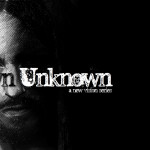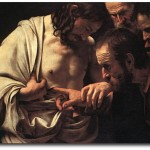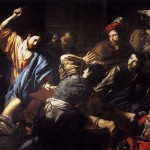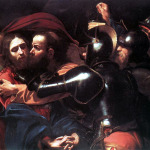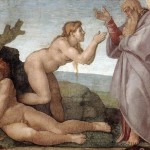We’ve been exploring the evidence for John 19:34 as an allusion to Eve’s creation from the side of Adam (Genesis 2:21-22). While the parallels between the two passages are suggestive, a great deal of supporting evidence is found in the allusions seamless connection to John’s core message and themes. In my last post we showed how it fits John’s theme of new creation. We now turn to look how it pertains to the topic of new birth.
The New Birth
The new birth is a essential theme in the Gospel of John. As with the theme of new creation, the new birth fittingly illustrates John’s emphasis on life and the new beginnings. In fact Andrew Koestenberg, A Theology of John’s Gospel and Letters deals with the new birth under the the theme of new creation. But since this series is specifically about Jesus giving birth, I thought it important to deal with it in more depth here. The concept of new birth comes up at least four times in John’s gospel.
John’s Prologue (1:11-13): John mentions the new birth first in his 18 verse prologue. John 1:11-13 states,
He (Jesus) came to that which was his own, but his own did not receive him. But to all who did receive him, who believed in his name, he gave the right to become children of God, who were born, not of blood nor the will of the flesh nor the will of man, but of God.
According to John, the whole point of Jesus coming was to give those who received him the power to become children of God by being specifically born of God. This statement is underscored by its central position within it’s surrounding context. John 1:1-18 is a chiasm, an ancient symmetrical pattern which pivots around and ultimately points to a central core. According to Alan Culpepper and other New Testament scholars, this statement about the new birth is its core. As such it should be seen as a complementary purpose statement to John’s Gospel. Whereas John 20:30-31 states,
Now Jesus did many other signs in the presence of the disciples, which are not written in this book; but these are written so that you may believe that Jesus is the Christ, the Son of God, and that by believing you may have life in his name.
Born Again (John 3:3-6): The new birth next appears in Jesus night time conversation with the aged Pharasee, Nicodimus. Jesus tells him outright, no one can see the kingdom of God unless he is born again. But Nicodimus is confused. “How can a man can be born when he is old”, he asks. “Can he entered his mothers womb a second time?” Nicodimus has clearly stumbled of Jesus use of the word again, the Greek word anothen. Jesus clarifies his statement, this is not a second human birth but a birth from above, from the Spirit of God. But unless a man be born of water and the Spirit he cannot enter the Kingdom of God. Anothen, is ambiguous. It can mean a “second time” but it also can mean “from above.” Jesus doesn’t mean for Nicodims to repeat his first birth but rather to experience a entirely new birth “from above.” Jesus clarifies his statement this when he says If you want to see the kingdom of God you must be born of water and the Holy Spirit.
Great. We know what the Holy Spirit means but exactly what does John mean by water.
To Come out of a Man’s Side
Looking at Genesis 2:21-22 it certainly feels like the first birth in the bible. There’s the suggestion of a twist in the fact that a woman is coming out of man instead of the other way around. Would the original readers of the Bible have seen it this way? J. Bergman Kline notes in this Journal of Evangelical Theological Society article that to come out of a man’s body is a typical idiom in the Old Testament for a man’s children and decedents. Look at the following expressions.
- “The LORD hath sworn in truth unto David; he will not turn from it; Of the fruit of your body (Hebrew: בֶּטֶן Greek: ἐκ καρποῦ τῆς κοιλίας σου) will I set upon your throne.” (Psalms 132:11)
- “I will set up your seed after you, which will come out of your inner most being (Hebrew: אֲשֶׁר יֵצֵא מִמֵּעֶיךָ Greek: ὃς ἔσται ἐκ τῆς κοιλίας σου) (2 Samuel 7:12)
- ‘your son who will come out of your loins (Hebrew: הַיֹּצֵא מֵחֲלָצֶיךָ Greek: ὁ ἐξελθὼν ἐκ τῶν πλευρῶν σου) (1 Kings 8:19)
While they’re just verbal expression, it does appear to suggest that these people saw men has having a counter part to the woman’s birth. This is further seen in the range of meaning of the Hebrew and Greek expressions which are somewhat obscured by English. For instance the word loins in Hebrew (חָלָץ) is not exclusive to men. It’s also the seat of pain as in a woman’s travail. Nor is womb only possessed by women. The Hebrew (בֶּטֶן) and Greek (κοιλίας) has the broader meaning of belly, abdomen and body, both possesssed by women and men. Note that Jesus uses this same Greek word in John 7:37-39 in speaking about his belly as the source of living water,
“If anyone thirsts, let him come to me and drink. Whoever believes in me, as the Scripture has said, ‘Out of his κοιλίας will flow rivers of living water.’”
This is not to say that the Biblical writers saw no differences between men and women. They did. Its to say that they saw these differences as more complementary and parallel then we perhaps this today.
There’s also a further range of meaning which needs to be noted. While in Hebrew 1 Kings 8:19 says ‘your son who will come out of your loins (Hebrew: הַיֹּצֵא מֵחֲלָצֶיךָ), the LXX translators, who transcribed the Hebrew Bible into Greek just before the time of Christ felt perfectly comfortable rendering this as ὁ ἐξελθὼν ἐκ τῶν πλευρῶν σου, “the one who comes forth from your sides.” Loins in Hebrew (חָלָץ) in the time of Christ is synonymous with the Greek word for sides (πλευρῶν)
1 Kings 8:19 and John 19:34 are the only verse in the Bible which contain the verb ἐξέρχομαι (to come out) and πλευρά (side).
The range of meaning of the Hebrew and Greek is very suggestive. For instance of these words in the Hebrew and Greek is even more suggestive then they first might appear in our English translations. For instance, the Hebrew and Greek for belly is the same word used for womb. And loins is simply a synonym for womb (2 Samuel 16:11). And this same word can also be translated as side in Greek.
And to this list we could add still one more. The scholars who translated the Old Testament into Greek some 200 years before the time of Christ thought that these expressions were parallel with saying coming from a man’s side. In the Hebrew, 1 Kings 8:19 reads “my son, which came forth of my bowels.” But LXX translators felt that
(which in Hebrew (בֶּטֶן) and Greek (κοιλίας) is the same word for womb).
of the The LXX, the Greek translation of the Old Testament done approximately 200 years before the time of Christ, has an interesting translation of the And a further parallel can be deduced from these idioms.
Compare 2 Samuel 16:11 and 1 Kings 8:19)
come out of a man’s side
The creation of Eve from the side of Adam, should thus be seen as the first birth to occur in scripture. Just as the initiating seed comes forth from the man to begin the birth process so to the woman initially proceeded from the man.
While these idioms are used in many places in the Old Testament, the quotes above are specifically in reference to God’s promise to David that his descendant will be established on the throne and will build the Temple. Kline notes that “1 Kings 8:19 and John 19:34 are the only verses in the Bible which contain the verb ἐξέρχομαι and the noun πλευρά.
The woman cannot give birth without the initial seed of the man. That’s why it was quite natural for the Hebrews to think that the first woman must have also first proceeded from a man.
The LXX of 1 Kings 8:19 shows that the phrase, “the one who comes forth from the belly,” can be equivalent to “the one who comes forth from the sides” as can be seen from the fact that each may refer to a son. This possible interchangeability between belly ( ) and side (pluera) suggests a close relationship between Jesus’ statement that ‘he who believes in me… rivers of living water will flow from his belly ( ) and John’s statement that “immediately blood and water came out” from the pierced “side” (pluera) of Jesus (19:34).
John’s theme of new birth and that of new creation are connected. Both are ultimately about new beginnings. In fact Andrew Koestenberg, A Theology of John’s Gospel and Letters deals with the new birth under the the theme of new creation. But since this series is specifically about Jesus giving birth, I thought it important to deal with it in more depth on its own.
The concept of birth comes up a number of times in the gospel of John. It first appears at the beginning of John’s gospel. John 1:11-13,
He (Jesus) came to that which was his own, but his own did not receive him. But to all who did receive him, who believed in his name, he gave the right to become children of God, who were born, not of blood nor the will of the flesh nor the will of man, but of God.
The fact that this is at the beginning of the gospel is significant but its more significant the central pivot around which John’s eighteen verse prologue hinges. John 1:1-18 is structured as a chiasm, an ancient symmetrical pattern which pivots around and ultimately points to a central core. A Chaism, according to David Dorsey,
generally features two sets of units, in which the units of the second set match in reverse order the units of the first set: a-b-c // c’-b’-a’. There is often an unmatched central unit linking the two matching sets: a-b-c-b’-a’ (some-times called “uneven chiasmus”). An example of a simple chiasmus from English literature is Pope’s line” “a wit with dunces, and a dunce with wits.”
John 1:12 and 13 is that core. John it seems is stressing the theme of new birth from God from the start.
The theme of new birth again appears in Jesus night time conversation with the aged Pharasee, Nicodimus. The theme is underscored in Nicodimus’ misunderstanding of Jesus.
The pattern of misunderstanding is charachterized by the following elements: (1) Jesus makes a statement, (2) it is misunderstood and (3) he or the narrator in turn must decipher the meaning of what has been said. The pattern itself suggests its function.
In his book the Anatomy of the Fourth Gospel, R. Alan Culpepper notes that the misunderstandings blatantly instruct readers on how they should read the gospel.
The misunderstandings call attention to the gospel’s metaphors, double-entendres, and plurisignations as well as guide the reader by interpreting some of these and ruling out the literal, material, worldly, or general meanings of such references. Readers are therefore oriented to the level on which the gospel’s language is to be understood and warned that failure to understand identifies them with the characterization of the Jews and the others who cannot interpret the gospel’s language correctly.”
Which leads Jesus to significantly rephrase the meaning again. The greek word that Jesus uses for again, anothen, is a bit ambigious. It can mean, as Nicodimus interprets it, a second time. But it also can mean “from above.”
It appears in Jesus night time conversation with Nicodimus. It appears in opening the eyes of the man born blind and the raising of Lazarus. It also is becomes a metaphor for the experience of joy after suffering in Jesus upper room discourse.
The new birth is certainly central to John. Can we see the flow of blood and water as a new birth?
Evangelicals love the term “born again.” It fittingly descibes our experience of salvation. But we miss something significant if we think it only refers to a personal experience of salvation. In the Gospel of John it’s part of larger theme which helps to reveal John 19:34 as the moment Jesus himself gave birth.
The term “born again” comes from John 3 and Jesus important night time conversation with the aged Pharasee, Nicodimus. Jesus says, if any man would enter the kingdom he must born again. But Nicodimus is confused. How can a man can be born when he is old, he asks. Can he entered his mothers womb a second time? But the Greek word Jesus used for again, anothen, is ambiguous. It can mean a “second time” but it also can mean “from above.” Jesus doesn’t mean for Nicodims to repeat his first birth but rather to experience a entirely new birth “from above.” Jesus clarifies his statement this when he says If you want to see the kingdom of God you must be born of water and the Holy Spirit.
Great. We know what the Holy Spirit means but exactly what does John mean by water.
John 3, though significant, isn’t the first or the last time new birth appears in the gospel of John. It appears first in John’s eighteen verse prologue. In 1:12 and 13 he say,
But to all who did receive him, who believed in his name, he gave the right to become children of God, who were born, not of blood nor the will of the flesh nor the will of man, but of God.
And its not just the beginning of the gospel. John 1:12 and 13 forms the pivotal center of John’s prologue (John 1:1-18). Alan Culpepper has noted that John 1:1-18 is structured as a chiasm, an ancient parallel pattern which pivots around and ultimately points to a central core. And here John 12 and 13 forms the core.
But to all who did receive him, who believed in his name, he gave the right to become children of God, who were born, not of blood nor the will of the flesh nor the will of man, but of God.
John makes the new birth the central theme of his gospel.
John summarizing statement at the end of his gospel merely rephrases this theme. “these things are written that you may believe that Jesus is the Christ and by believing you may have life in his name.” The birth or new life is again central here as well.
You must have new life. You must be born again.
But how?
The only thing we know thus far is that it comes from God and is not a natural birth and it relates in some sense to water and the Holy Spirit.
But the imagery of birth comes up again in John 16.
20 Truly, truly, I say to you, you will weep and lament, but the world will rejoice. You will be sorrowful, but your sorrow will turn into joy. 21 When a woman is giving birth, she has sorrow because her hour has come, but when she has delivered the baby, she no longer remembers the anguish, for joy that a human being has been born into the world. 22 So also you have sorrow now, but I will see you again, and your hearts will rejoice, and no one will take your joy from you.
Here Jesus compares the sorrow of the disciples with the sorrow of a woman in labor. The analogy indicates that the disciples are the ones who are in the agony of labor. but afterwards they will experience the joy of Jesus as new mother experiences the joy of her new baby. Jesus in his death and resurrection is the one who is being born again.
But the metaphor is strangely suggestive of Jesus’ own suffering. The disciples and their pain does not bring about the birth (i.e resurrection) of Jesus. But Jesus suffering will bring about there new birth (John 1 and 3). Perhaps Jesus didn’t want us to take the analogy that far.
Or perhaps He wanted us to take it further.
The birth imagery reminds us of the John 1 and John 3 where God and the Holy Spirit are the active agents in the new birth. And certainly Jesus is likewise an agent in the new birth. The metaphor of labor pains can also be suggestive of Jesus’ own pain, the pain he will experience in his suffering on the cross. While it’s true the disciples will experience emotional pain, Jesus will quit literally experience the agony of physical suffering just as the woman in labor.
The point of the John’s gospel is the new birth and the climax of John’s gospel is the cross and resurrection. And here in John 16 we find an analogy which is suggestive of those two ideas together. Labor and the cross as the means to new birth.
So is possible that Jesus and John are suggesting that the crucifixion is in fact that moment Jesus gave birth.
Does Jesus give birth in the crucifixion? Where does he give birth in the crucifixion?
Christians throughout the ages have see in John 19:34, the piercing of Christ’s side and subsequent flow of blood and water, an allusion to Eve’s creation (Genesis 2:21-22). The only male birth to appear in the scriptures.
In the Old Testament we also find idioms in which ‘what comes out from one’s side’ refers to offspring. The following expressions refer to children or descendants:
- (1) “that which comes from the loins”
- (2) “the fruit of the belly/womb” ;
- (3) “the descendants of the belly” ; and
- (4) one will come forth from your inward parts.”
The LXX of 1 Kings 8:19 shows that the phrase, “the one who comes forth from the belly,” can be equivalent to “the one who comes forth from the sides” as can be seen from the fact that each may refer to a son. This possible interchangeability between belly ( ) and side (pluera) suggests a close relationship between Jesus’ statement that ‘he who believes in me… rivers of living water will flow from his belly ( ) and John’s statement that “immediately blood and water came out” from the pierced “side” (pluera) of Jesus (19:34).
Many details of the crucifixion are unique to John. But the one he offers as by far the most important is the piercing of Jesus’ side and the flow of blood and water.
It’s clear from the eyewitness testimony that follows (19:35) John perceives in them a unique importance.
He who saw it has borne witness – his testimony is true, and he knows that he is telling the truth – that you also may believe.
Three times he swears to the event. And his conclusion, “that you also may believe,” foreshadows the very conclusion of John.
But these have been written that you may believe that Jesus is the Christ…
So striking is this witness its has been called, “the most solemn protestation of accuracy to be found in the whole work.” No where does John make a more passionate and personal claim.
But the flow is also extremely significant because it forms a climax to John’s frequent symbolic and metaphorical depictions of water. Among those numerous depictions is Jesus’ reference to a birth of water in John 3:5.
Among the many things that John does with this verse, it uses it to depict the New Birth of God’s people. The early Church saw in the piercing of Jesus’ side and the flow of blood and water an allusion to the creation of Eve (Genesis 2:21-22). As early as the second century we find it said
If Adam was a figure of Christ, the sleep of Adam was the death of Christ who was to fall asleep in death; that in the injury of His side might be figured the Church, the true mother of the living.
far from being a crazy interpretation this allusion appears in all likelihood to be intended by John himself. We can see in quotes of the church fathers the following points of similarity.
- In the Old Testament we also find idioms in which ‘what comes out from one’s side’ refers to offspring. The following expressions refer to children or descendants: (1) “that which comes from the loins”; (2) “the fruit of the belly/womb” ; (3) “the descendants of the belly” ; and (4) one will come forth from your inward parts.” The LXX of 1 Kings 8:19 shows that the phrase, “the one who comes forth from the belly,” can be equivalent to “the one who comes forth from the sides” as can be seen from the fact that each may refer to a son. This possible interchangeability between belly ( ) and side (pluera) suggests a close relationship between Jesus’ statement that ‘he who believes in me… rivers of living water will flow from his belly ( ) and John’s statement that “immediately blood and water came out” from the pierced “side” (pluera) of Jesus (19:34).
- New Creation
- Marriage
- Oneness
How Can I Be Born Again? The Answer from John’s Gospel is the Death of Christ. In the labor pains of his death he has given birth to those born of water and the Spirit.
And that’s where all explicit references to birth imagery end. But it’s not where the imagery itself ends.
We should note that the metaphor of a labor pains can also be suggestive of Jesus’ own pain, the pain he will experience in his suffering on the cross. While its true the disciples will experience emotional pain, it is perhaps even more true of Jesus who will quit literally experience the agony of physical suffering.
This is where the direct references to the new birth end. But this metaphor suggests we take a closer look at the cross in John and it’s unique climactic moment.
John underscores the theme of the new birth by placing it at the pivotal center of his 18 verse, introduction (1:1-18). http://journals.cambridge.org/action/displayAbstract?fromPage=online&aid=3399184 John’s prologue is chjasms. We’re not familiar with chaisms today but John and his readers certainly were. A Chaism is form of parallelism. Many psalms are built around a simple A, B, A, B C, pattern. Chiasms structure there parallelism around a central core. A, B, C, D, C, B, A.







